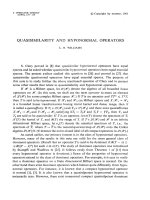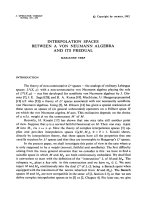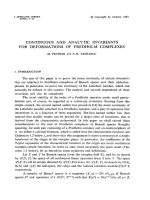Báo cáo toán học: " Packing and covering a unit equilateral triangle with equilateral triangles" pot
Bạn đang xem bản rút gọn của tài liệu. Xem và tải ngay bản đầy đủ của tài liệu tại đây (88.47 KB, 8 trang )
Packing and covering a unit equilateral triangle with
equilateral triangles
Yuqin Zhang
1
Yonghui Fan
2∗
1
Department of Mathematics
Beijing Institute of Technology, 100081, Beijing, China
email:
2
College of Mathematics and Information Science
Hebei Normal University, 050016, Shijiazhuang, China
Submitted: Jun 7, 2005 ; Accepted: Oct 20, 2005; Published: Oct 25, 2005
Abstract
Packing and covering are elementary but very important in combinatorial geom-
etry, they have great practical and theoretical significance. In this paper, we discuss
a problem on packing and covering a unit equilateral triangle with smaller triangles
which is originated from one of Erd˝os’ favorite problems.
Keywords: packing, minimal covering
Mathematics Subject Classification (2000): 52C15
1 Introduction
Packing and covering are elementary but very important in combinatorial geometry, they
have great practical and theoretical significance. In 1932, Erd˝os posed one of his favorite
problems on square-packing which was included in [2]: Let S be a unit square. Inscribe n
squares with no common interior point. Denote by e
1
,e
2
, ,e
n
the sides length of these
squares. Put f (n)=max
n
i=1
e
i
.In[3],P.Erd˝os and Soifer gave some results of f(n).
In [1], Connie Campbell and William Staton considered this problem again. Because
packing and covering are usually dual to each other, we discussed a problem of a minimal
square-covering in [5]. In this paper, we generalize this kind of problem to the case
of using equilateral triangles to pack and cover a unit equilateral triangle, and obtain
corresponding results.
∗
Foundation items: This work is supported by the Doctoral Funds of Hebei Province in China
(B2004114).
the electronic journal of combinatorics 12 (2005), #R55 1
2 Packing a unit equilateral triangle
Firstly, we give the definition of the packing function:
Definition 2.1. Let T be a unit equilateral triangle. Inscribe n equilateral triangles
T
1
,T
2
, ,T
n
with no common interior point in such a way which satisfies: T
i
has side of
length t
i
(0 <t
i
≤ 1) and is placed so that at least one of its sides is parallel to that of T .
Define t(n)=max
n
i=1
t
i
.
In this part, we mainly exploit the method of [1] to get the bounds of t(n)andobtain
a corresponding result. Here we list some of the proofs so that the readers may better
understand.
Theorem 2.2. The following estimates are true for all positive integers n:
(1) t(n) ≤
√
n.
(2) t(n) ≤ t(n +1).
(3) t(n) <t(n +2).
Proof. (1)Let s be the vector (t
1
,t
2
, ,t
n
), where the t
i
denote the length of the sides
of the equilateral triangles in the packing, and let v be the vector (1, 1, ,1). Now
n
i=1
t
i
≤sv≤
n
i=1
t
2
i
n
1
2
=
2
√
3
n
i=1
(
√
3
2
t
2
i
)n
1
2
≤ n
1
2
.
It’s easy to get (2),(3) by replacing a T
i
with 2 or 3 equilateral triangles with sides of
length
t
i
2
.
Definition 2.3. For a equilateral triangle T , dissect each of its 3 sides into n equal parts,
then through these dissecting points draw parallel lines of the sides of T ,sowegeta
packing of T by n
2
equilateral triangles with sides of length
1
n
. Such a configuration
is called an n
2
-grid. When T is a unit equilateral triangle, the packing is a standard
n
2
-packing.
See Figure 1 for the case n =3.
Figure 1: a 3
2
-grid
Proposition 2.4. t(k
2
)=k.
the electronic journal of combinatorics 12 (2005), #R55 2
Proof. By Definition 2.3, it’s easy to know that for the standard k
2
-packing , n = k
2
,t
i
=
1
k
and
n
i=1
t
i
=
1
k
k
2
= k. So by the Definition of t(n),t(k
2
) ≥ k which along with Theorem
2.2(1) provides the desired equality.
Proposition 2.5. For k ≥ 2, t(k
2
− 1) ≥ k −
1
k
.
Proof. Consider the standard k
2
-packing with one equilateral triangle removed.
Theorem 2.6. If n is a positive integer such that (n −1) is not a perfect square number,
then t(n) > (n − 1)
1
2
.
Proof. When n = k
2
, by Proposition 2.4, t(n)=
√
n>
√
n −1.
When n = k
2
− 1, by Proposition 2.5, t
2
(n) ≥ (k −
1
k
)
2
= k
2
− 1 − 1+
1
k
2
>n− 1.
That is t(n) >
√
n −1.
When n = k
2
, k must lie between two perfect square numbers of different parity. That
is, there is an integer k such that k
2
<n<(k +1)
2
, n −k
2
and (k +1)
2
−n have different
parity. When neither n − 1norn + 1 is a perfect square number, consider the values of
n where k
2
+1<n<(k +1)
2
− 1, there are two cases which provide the lower bound of
t(n) for all n on the interval [k
2
+2, (k +1)
2
− 2]:
Case 1. (k+1)
2
−n is odd. Say, (k+1)
2
−n =2a+1(a ≥ 1), k
2
<n≤ (k+1)
2
−3. From
a standard (k +1)
2
-packing of T ,removean(a +1)
2
-grid and replace it with an a
2
-grid
packing the same area. The result is a packing of (k+1)
2
−(a+1)
2
+a
2
=(k+1)
2
−2a−1=
n equilateral triangles, the sum of whose length is [(k+1)
2
−(a+1)
2
]
1
k+1
+a
2
(
a+1
a
)(
1
k+1
)=
k +1−
a+1
k+1
.
So t(n) ≥ k +1−
a+1
k+1
, t
2
(n) ≥ (k +1−
a+1
k+1
)
2
=(k +1)
2
−2a −1+(
a+1
k+1
)
2
−1 >n−1.
That is, t(n) >
√
n −1.
Case 2. n − k
2
is odd. Say, n − k
2
=2a − 1(a ≥ 2), k
2
+3 ≤ n<(k +1)
2
.
From a standard k
2
-packing of T ,removean(a −1)
2
-grid and replace it with an a
2
-grid
covering the same area. The result is a packing of k
2
− (a − 1)
2
+ a
2
= k
2
+2a − 1=n
equilateral triangles of the unit equilateral triangle T . The sum of the length of sides is
[k
2
− (a −1)
2
]
1
k
+ a
2
(
a−1
a
)(
1
k
)=k +
a−1
k
.
So t(n) ≥ k +
a−1
k
, t(n)
2
≥ (k +
a−1
k
)
2
= k
2
+2a − 1+(
a−1
k
)
2
− 1 >n− 1. That is,
t(n) >
√
n −1.
Similar to [1], by Theorem 2.6, we can easily get the following result.
Theorem 2.7. If t(n +1)=t(n), then n is a perfect square number.
On the other hand, we think the following is right:
Conjecture 2.8. t(n
2
+1)=t(n
2
).
the electronic journal of combinatorics 12 (2005), #R55 3
3 Covering a unit equilateral triangle
Definition 3.1. Let T be a unit equilateral triangle. If n equilateral triangles T
1
,T
2
, ,T
n
can cover T in such a way which satisfies:
(1) T
i
has side of length t
i
(0 <t
i
< 1) and is placed so that at least one of its sides is
parallel to that of T ;
(2) T
i
can’t be smaller, that is, there doesn’t exist any T
i1
⊂ T
i
such that {T
j
,j =
1, 2, ,i− 1,i+1, ,n}∪{T
i1
} can cover T . (Here we admit translation.)
We call this kind of covering a minimal covering.
In the meaning of the minimal covering, define:
T
1
(n)=min
n
i=1
t
i
, T
2
(n)=max
n
i=1
t
i
.
When n ≤ 2, since 0 <t
i
< 1, each T
i
(i =1, 2) can only cover one corner of a unit
equilateral triangle, but it has three corners, so T
1
,T
2
can’t cover T . That is, when n ≤ 2,
T
i
(n)(i =1, 2) has no meaning. So in the following, let n ≥ 3.
3.1 The upper bound of T
1
(n)
Theorem 3.2. When n is even, T
1
(n) ≤ 3 −
4
n
.
Proof. Consider a covering of a unit equilateral triangle T with a equilateral triangle T
1
which has side of length x and n −1 equilateral triangles T
2
,T
3
, ,T
n
each of which has
sides of length 1 − x such that
n
2
(1 − x) = 1, which implies x =1−
2
n
. When n =6,
see Figure 2 for the placement. It’s easy to see this is a minimal covering. So by the
definition of T
1
(n), T
1
(n) ≤ x +(n −1)(1 − x)=3−
4
n
.
T
1
T
2
T
3
T
4
T
5
T
6
Figure 2: a unit equilateral triangle covered by six smaller equilateral triangles
Proposition 3.3. T
1
(3) ≤ 2.
Proof. Consider a covering of a unit equilateral triangle T with 3 equilateral triangles
T
1
,T
2
,T
3
each of which has sides of length
2
3
. See Figure 3 for the placement. It’s easy to
see this is a minimal covering. So by the definition of T
1
(n), T
1
(3) ≤ 3 ×
2
3
=2.
the electronic journal of combinatorics 12 (2005), #R55 4
T
1
T
2
T
3
Figure 3: a unit equilateral triangle covered by 3 smaller equilateral triangles
Proposition 3.4. T
1
(5) <
9
4
.
Proof. Consider a covering of a unit equilateral triangle T with one equilateral triangle T
1
which has side of length x, 2 equilateral triangles T
2
,T
3
each of which has sides of length
y and 2 equilateral triangles T
4
,T
5
each of which has sides of length 1 − x, such that
y<2(1 − x)and2y − x =
x−(1−x)
2
, which implies y = x −
1
4
and
1
2
<x<
3
4
.SeeFigure
4 for the placement. It’s easy to see this is a minimal covering. So by the definition of
T
1
(n), T
1
(5) ≤ x +2y +2(1− x)=x +
3
2
<
3
4
+
3
2
=
9
4
.
T
1
T
2
T
3
T
4
T
5
Figure 4: a unit equilateral triangle covered by 5 smaller equilateral triangles
Theorem 3.5. When n is odd and n ≥ 7, T
1
(n) ≤ 4 −
6
n−3
.
Proof. Consider a covering of a unit equilateral triangle T with 4 equilateral triangles
T
1
,T
2
,T
3
,T
4
each of which has side of length x and n−4 equilateral triangles T
5
,T
6
, ,T
n
each of which has sides of length 1 − 2x , such that
(n−3)(1−2x)
2
= 1 which implies x =
1
2
−
1
n−3
.whenn = 7, see Figure 5 for the placement. It’s easy to see this is a minimal
covering. So by the definition of T
1
(n), T
1
(n) ≤ 4x +(n −4)(1 − 2x)=4−
6
n−3
.
Here we can’t give the lower bound of T
1
(n), but it seems obvious that the following
is right:
Conjecture 3.6. T
1
(n) ≥ 2.
the electronic journal of combinatorics 12 (2005), #R55 5
T
1
T
2
T
3
T
4
T
5
T
6
T
7
Figure 5: a unit equilateral triangle covered by seven smaller equilateral triangles
3.2 The bounds of T
2
(n)
Proposition 3.7. T
2
(k
2
) ≥ k.
Proof. It’s easy to see that a standard n-packing is also a standard n-covering. By the
proof of Proposition 2.4 and the definition of T
2
(n), the assertion holds.
Proposition 3.8. T
2
(k
2
+1)≥ k.
Proof. From a standard k
2
-covering, remove a 2
2
-grid and replace it with equilateral
triangles T
i1
,T
i2
, ,T
i5
covering the same area which are placed as Figure.4 such that
T
i1
is the largest equilateral triangles of {T
ij
| j =1, 2, ,5} which implies that t
i1
≥
1
k
and t
i2
= t
i3
=
2
k
−t
i1
, t
i4
= t
i5
= t
i1
−
1
2k
. The result is a covering of k
2
−4+5=k
2
+1
equilateral triangles, the sum of whose length is t = k −
4
k
+ t
i1
+2(
2
k
−t
i1
)+2(t
i1
−
1
2k
)=
k −
1
k
+ t
i1
≥ k.
Obviously, any equilateral triangle of {T
ij
| j =1, 2, ,5} can’t be smaller. This
covering is a minimal covering, so we have T
2
(k
2
+1)≥ k.
Proposition 3.9. T
2
(k
2
− 1) ≥ k −
3
2k
.
Proof. From a standard k
2
-covering, remove a 3
2
-grid and replace it with eight equilateral
triangles T
i1
,T
i2
, ,T
i8
covering the same area which are placed as Figure 6 such that T
i1
is the largest equilateral triangles of {T
ij
| j =1, 2, ,8} and t
i2
= t
i3
= t
i4
= t
i5
= t
i6
=
t
i7
= t
i8
=
3
k
−t
i1
. It’s obvious that 0 <t
ij
<
3
k
(j =1, 2, ,8). And 4(
3
k
−t
i1
)=
3
k
which
implies t
i1
=
9
4k
. The result is a covering of k
2
−9+8 = k
2
−1 equilateral triangles, the sum
of whose length is t = k −
9
k
+ t
i1
+7(
3
k
−t
i1
)=k +
12
k
−6t
i1
.Sot ≥ k +
12
k
−6t
i1
= k −
3
2k
.
Obviously, any equilateral triangles of {T
ij
| j =1, 2, ,8} can’t be smaller. So any
one of the resulting k
2
−1 equilateral triangles can’t be smaller. This covering is a minimal
covering, so T
2
(k
2
− 1) ≥ k −
3
2k
.
It’s easy to see that a standard n-packing is also a standard n-covering. By the proof
of Theorem 2.6 and the definition of T
2
(n), we can get the following result in a similar
way:
Theorem 3.10. If neither n−1 nor n+1 is a perfect square number, then T
2
(n) >
√
n −1.
the electronic journal of combinatorics 12 (2005), #R55 6
T
1
T
2
T
3
T
4
T
5
T
6
T
7
T
8
Figure 6: a 3
2
-grid covered by eight equilateral triangles
To get an upper bound of T
2
(n), we first list the following lemma which is a known
result of [4]:
Lemma 3.11. [4] Let T be a triangle and let {T
i
}
n
i=1
be a sequence of its positive or
negative copies. If the total area of {T
i
}
n
i=1
is greater than or equal to 4|T |(where |T |
denotes the area of T ), then {T
i
}
n
i=1
permits a translative covering of T .
Theorem 3.12. T
2
(n) ≤ 4
√
n.
Proof. Let {T
i
}
n
i=1
be a minimal covering of the unit equilateral triangle T ,andt
i
denote
the length of the side of T
i
(i =1, 2, ,n). We first prove that
n
i=1
√
3
2
t
2
i
≤ 2
√
3. Otherwise,
if
n
i=1
√
3
2
t
2
i
> 2
√
3, there exists a T
i1
⊂ T
i
, such that t
i1
<t
i
and
√
3
2
(t
2
i1
+
i−1
j=1
t
2
j
+
n
j=i+1
t
2
j
) ≥
2
√
3. Notice that the area of a unit equilateral triangle is
√
3
2
and all equilateral triangle are
homothetic, by Lemma 3.11, T
1
,T
2
, ,T
i−1
,T
i1
,T
i+1
, ,T
n
can cover the unit equilat-
eral triangle T , which contradicts the definition of a minimal covering . So
n
i=1
√
3
2
t
2
i
≤ 2
√
3.
Let s be the vector (t
1
,t
2
, ,t
n
), and let v be the vector (1, 1, ,1). Now
n
i=1
t
i
≤
sv≤
n
i=1
t
2
i
n
1
2
=
2
√
3
n
1
2
n
i=1
√
3
2
t
2
i
≤
2
√
3
2
√
3n
1
2
=4
√
n.SoT
2
(n) ≤ 4
√
n.
We also have the following unsolved problem:
Problem: Improve the upper bound of T
2
(n).
4 The case of isosceles right triangle with legs of
length 1
All the results above can be generalized to the isosceles right triangle with legs of length
1inthesameway.
the electronic journal of combinatorics 12 (2005), #R55 7
Acknowledgement
We thank the anonymous referee for a prompt, thorough reading of this paper and
for many insightful suggestions. We also would like to thank the referee for calling our
attention to the paper [3].
References
[1] Connie Campbell and William Staton, A Square-packing problem of Erd˝os, The Amer-
ican Mathematical Monthly, Vol.112 (2005), 165–167.
[2] P.Erd˝os, Some of my favorite problems in number theory, combinatorics and geometry,
Resenhas 2 (1995), 165–186.
[3] P.Erd˝os and Soifer, Squares in a square, Geombinatorics IV (1995), 110–114.
[4] Janusz Januszewski, Covering a triangle with sequences of its homothetic copies, Pe-
riodica Mathematica Hungarica, Vol.36(2-3) (1998), 183–189.
[5] Yuqin Zhang and Yonghui Fan, A Square-covering problem, submitted.
the electronic journal of combinatorics 12 (2005), #R55 8









